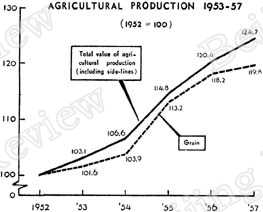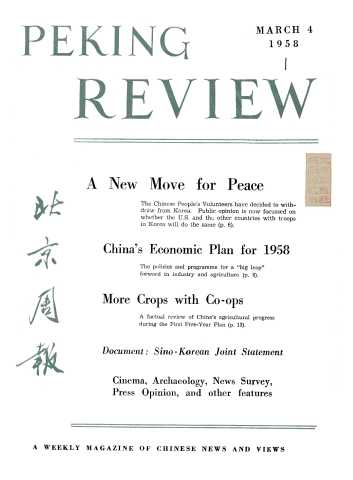During the First Five-Year Plan period China's farm output increased steadily year after year. Agricultural co-operation played a key role in bringing this about.
CROP reports show that, in spite of droughts and other natural calamities, 1957, the last year of China's First Five-Year Plan, was a successful one for agriculture. At year's end, the main targets for agricultural production for the entire plan had been either fulfilled or exceeded. The 1957 grain crop was estimated at 370,000 million catties, surpassing the planned target by 1.9 per cent. The cotton crop reached the unprecedented total of 32.8 million piculs, topping the set mark by 0.3 per cent. The total value of agricultural production (including side-lines) was 60,349 million yuan. This was 1.2 per cent in excess of the Five-Year Plan target for 1957.
Nature was not kind to China during the First Five-Year Plan. Serious floods occurred in 1954 and 1956. In 1953 and 1957 there were also natural calamities, though smaller in extent. Only 1955 could be considered a good year. Yet, both the total value of agricultural production and the most important single item - grain - increased year by year and at a fair speed.

The total grain output during the five-year period was 1,719,000 million catties, 25,000 million catties more than planned. The yield in 1957 was 70 per cent higher than 1949, the year of liberation, and topped the pre-liberation peak (1936) by a third. This means that since liberation, the grain crop increased at a much faster rate than the population (about 2.2 per cent a year).
The cotton crop in 1957 was 3.69 times the 1949 level, and 1.93 times the pre-liberation peak in 1936. As a result, people were better fed and more warmly dressed.
High Yields in Large Areas
Another notable feature was that high yields were achieved not only on small isolated plots but by whole counties or even administrative areas embracing several counties. The fifteen counties and two rural sections of municipalities comprising the Swatow special administrative area, Kwangtung Province, have a total of 5,640,000 mou of land planted to grain crops. By 1956, the average output per mou here had reached a record 811.6 catties.
In 1957, sixty-five counties and rural sections of municipalities, out of a national total of some two thousand, reached the targets set for 1967, ten years hence, in the National Programme for Agricultural Development (1956-67) - 400, 500 or 800 catties per mou depending on the locality. Four former grain-deficit provinces - Kwangtung, Fukien, Kansu and Kweichow - had become self-sufficient or produced a surplus.
A total of 184 counties and rural sections of municipalities have already reached the 1967 target yields of 40, 60, 80 or 100 catties of ginned cotton per mou. In 1957, the nation planted 86,520,000 mou to cotton; the 1967 goal in yields was reached on nearly a third of this area.
Another significant indication of what to expect in the future is that in some places, production rose not gradually, but by leaps and bounds. Between 1952 and 1957, the two counties of Huangyen and Wenlin in Chekiang Province increased grain yields by 43 and 65 per cent respectively. Macheng County, Hupeh Province, achieved a really phenomenal increase in cotton yield - from an average 60 catties per mou in 1956 to 103 catties per mou in 1957. These were records made by entire counties. In the case of individual co-ops, it was not uncommon for yields to be increased several times over.
How did these achievements become possible?
Co-operation-Secret of Success
The fact that most of the advances were made in 1956 and 1957, the first two years since the co-operative reorganization of agriculture was basically completed, gives the clue. Take Hsinyeh, for instance, a cotton-growing county in Honan Province. In the past, it raised less than 20 catties per mou. Its cotton fields were scattered among various households each working on its own. With the completion of agricultural co-operation in 1956, the co-ops could concentrate their cotton growing on plots of high-lying, dry land suitable for this crop. Forty thousand co-op members were organized to specialize in cotton growing; this made it possible to introduce new techniques and more intensive farming in general. As a result, the per mou yield jumped to 34 catties in 1956 and 53 catties in 1957. Socialist co-operative farming turned the trick by making it possible to use land and manpower in a planned, rational way. It is common knowledge that the power of a group is often far greater than the sum total of that of the same individuals working singly.
In most parts of China, the climate permits multiple cropping. But individual peasants seldom attempted it (except in the warm southern areas). This was because to harvest one crop and then plant another must be done in a very short time if it is to be successful. The individual peasant did not have the resources and labour power for this; and failure might lead to bankruptcy.
By 1956, when China's 110 million peasant households were organized into some 750,000 co-ops, the whole situation changed radically. In that year, as a result of multiple cropping, the sown area increased by more than 100 million mou.
Another obvious advantage of large-scale co-operative farming is that it allows for the use of machinery. Better strains of seeds give the best results only if sown on large tracts of land; on small plots, crossing with adjacent inferior strains and resulting degeneration are inevitable.
Pest-control also requires widespread co-ordinated effort for the simple reason that insects are mobile. And the larger the scale of the control effort, the lower the cost per unit of land.
For thousands of years, China's peasants stood practically helpless in the face of floods and droughts. To the old way of thinking, the harvest, bountiful or otherwise, depended not on men but on Heaven's will. The benefits of irrigation, of course, were well understood. As the saying went: "When water slakes our arid soil, there's three years' crop from one year's toil." Yet, up to the time of liberation in 1949, only 240 million mou of China's land were irrigated. This was less than one-sixth of the land tilled in the country. There were many reasons for this. The greater part of the land was owned by landlords; and the actual tillers were naturally reluctant to improve land which did not belong to them. A number of peasants did own some land. But ruthlessly exploited and poor as they were, they did not have the means to go in for irrigation in a big way. The most they could do was to sink a well or cut a small ditch. Small-scale ownership itself was an obstacle. Irrigation works of any size invariably involved questions of land rights. While all desired water, no one was willing to have any part of his small plot turned into a channel for the benefit of others.
Here too agricultural co-operation brought about a fundamental change. When land and labour power were pooled and employed in a planned way, old obstacles to irrigation disappeared. That was why the area under irrigation was increased by more than a third (over 100 million mou) in 1956 alone. When natural calamities strike, the peasants are no longer helpless, because they are organized. Hupeh Province was hit hard by drought in 1956. But members of the farm co-operatives pitched in to dig channels to bring water from sources scores of kilometres away. By such means they beat the drought. Hupeh's grain crop was 11.7 per cent bigger than the previous year's; its cotton crop was over 37 per cent bigger.
The meaning of socialist co-operative farming goes even deeper than these facts indicate. As a new form of production, it transforms man himself. Ignorance, selfishness and a generally conservative outlook were the products of scattered, individual petty farming. Collective ownership of means of production and collective labour on the other hand, creates the feeling of common interest and cultivates the habit of mutual help. As production in the co-ops rises, they accumulate more common property, and men are brought together more closely. Even though some peasants don't yet feel thoroughly at home in the co-ops, and some of the better-off members have different ideas from the majority of the poorer ones as to how the co-ops should be run, there is already a basic unity of purpose - to achieve a common prosperity through collective labour. The socialist principle of distribution - to each according to his labour - serves as a most effective incentive to initiative in work.
Some Misconceptions
One prevalent misconception is that the peasants were reluctant to join co-ops because they didn't want to "lose" the land they received in the agrarian reform. The British journalist Richard Hughes wrote in the New Republic, New York, November 18, 1957: "It is difficult to believe that any peasant anywhere, after having been granted land for the first time in 1949, is delighted to have it taken back by the state eight years later."
This statement is a hodge-podge of untruths and misrepresentations. First, the Chinese Government did not nationalize land. In the co-op, individual land ownership has been replaced by ownership by the group, of which the original possessor is a member. If he withdraws from the co-op he takes his land with him.

Second and more important, what the peasant really wants is a better life, not the land per se. Before cooperation, land ownership was only a means to this end. In the past two years, agricultural co-operation had proved itself to be the best way to prosperity. That is why "not even a big stick can dissolve a co-op" as the peasants now say.
But this does not mean, naturally, that all 750,000 co-operative farms are excellently run. It would indeed be strange if they were. The co-ops are something quite new, and both their elected officials and the superior organs still lack experience in their management. A few, a very few, of the co-ops have failed to raise output. But what those properly-run have already accomplished shows that this is not the fault of the co-operative form of production but of poor management which can be improved.
Now, early in 1958, a new upsurge of productive activity is sweeping over the Chinese countryside on a scale greater even than in 1956. The co-ops are better organized than they were then, and the officials more experienced. China's farmers are confident of new successes this year.
CHINESE WEIGHTS and MEASURES at a GLANCE
1 mou=0.06 hectare or 0.1647 acre
1 tan (picul)=0.05 ton or 0.984 hundredweight
1 chin (catty) = 0.5 kilogramme or 1.1023 pounds


 Copy Reference
Copy Reference